BT Group: Analysis of Current Networking and Technology Trends
VerifiedAdded on 2020/11/12
|17
|5545
|227
Report
AI Summary
This report, prepared for BT Group, a leading UK internet service provider, delves into current trends in networking to inform infrastructure upgrades and service diversification. It begins with an introduction to networking and its evolution, emphasizing technologies like software-defined networking and 5G. The main body of the report compares wired and wireless broadband, detailing their performance metrics, deployment challenges, and the end-user experience. It then explores emerging technologies such as cognitive radio and unlicensed mobile access (UMA), outlining their functional architectures, benefits, and current deployment statuses. The report provides a comprehensive analysis of the evolving landscape of networking technologies, offering valuable insights for BT Group's strategic investment decisions. The report concludes with a summary of the key findings and recommendations for the future.

Current Trends in
Networking
Networking
Paraphrase This Document
Need a fresh take? Get an instant paraphrase of this document with our AI Paraphraser

Table of Contents
INTRODUCTION...........................................................................................................................1
MAIN BODY...................................................................................................................................1
Question 1...................................................................................................................................1
Question 2...................................................................................................................................4
Question 3...................................................................................................................................9
Question 4.................................................................................................................................11
CONCLUSION..............................................................................................................................13
REFERENCES..............................................................................................................................14
INTRODUCTION...........................................................................................................................1
MAIN BODY...................................................................................................................................1
Question 1...................................................................................................................................1
Question 2...................................................................................................................................4
Question 3...................................................................................................................................9
Question 4.................................................................................................................................11
CONCLUSION..............................................................................................................................13
REFERENCES..............................................................................................................................14
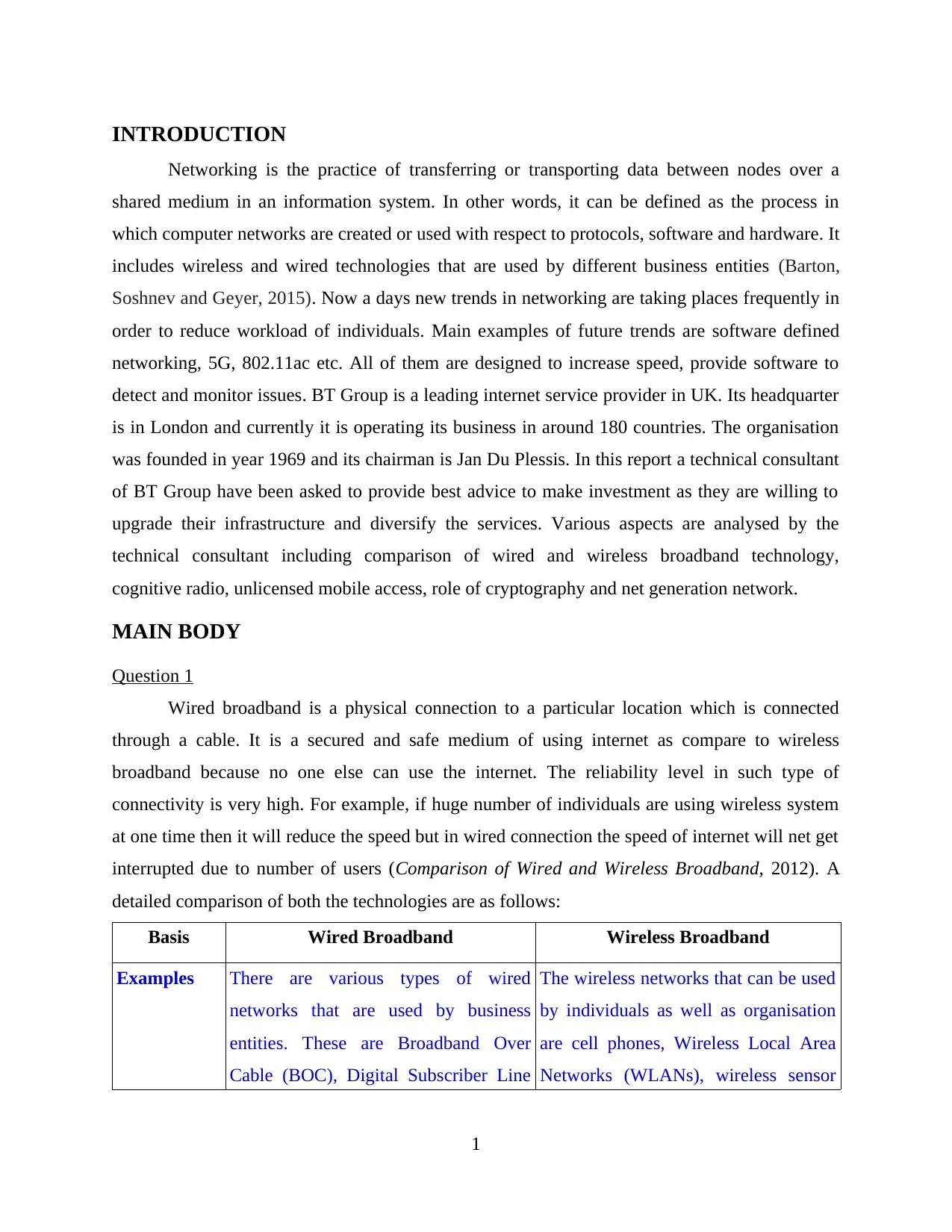
INTRODUCTION
Networking is the practice of transferring or transporting data between nodes over a
shared medium in an information system. In other words, it can be defined as the process in
which computer networks are created or used with respect to protocols, software and hardware. It
includes wireless and wired technologies that are used by different business entities (Barton,
Soshnev and Geyer, 2015). Now a days new trends in networking are taking places frequently in
order to reduce workload of individuals. Main examples of future trends are software defined
networking, 5G, 802.11ac etc. All of them are designed to increase speed, provide software to
detect and monitor issues. BT Group is a leading internet service provider in UK. Its headquarter
is in London and currently it is operating its business in around 180 countries. The organisation
was founded in year 1969 and its chairman is Jan Du Plessis. In this report a technical consultant
of BT Group have been asked to provide best advice to make investment as they are willing to
upgrade their infrastructure and diversify the services. Various aspects are analysed by the
technical consultant including comparison of wired and wireless broadband technology,
cognitive radio, unlicensed mobile access, role of cryptography and net generation network.
MAIN BODY
Question 1
Wired broadband is a physical connection to a particular location which is connected
through a cable. It is a secured and safe medium of using internet as compare to wireless
broadband because no one else can use the internet. The reliability level in such type of
connectivity is very high. For example, if huge number of individuals are using wireless system
at one time then it will reduce the speed but in wired connection the speed of internet will net get
interrupted due to number of users (Comparison of Wired and Wireless Broadband, 2012). A
detailed comparison of both the technologies are as follows:
Basis Wired Broadband Wireless Broadband
Examples There are various types of wired
networks that are used by business
entities. These are Broadband Over
Cable (BOC), Digital Subscriber Line
The wireless networks that can be used
by individuals as well as organisation
are cell phones, Wireless Local Area
Networks (WLANs), wireless sensor
1
Networking is the practice of transferring or transporting data between nodes over a
shared medium in an information system. In other words, it can be defined as the process in
which computer networks are created or used with respect to protocols, software and hardware. It
includes wireless and wired technologies that are used by different business entities (Barton,
Soshnev and Geyer, 2015). Now a days new trends in networking are taking places frequently in
order to reduce workload of individuals. Main examples of future trends are software defined
networking, 5G, 802.11ac etc. All of them are designed to increase speed, provide software to
detect and monitor issues. BT Group is a leading internet service provider in UK. Its headquarter
is in London and currently it is operating its business in around 180 countries. The organisation
was founded in year 1969 and its chairman is Jan Du Plessis. In this report a technical consultant
of BT Group have been asked to provide best advice to make investment as they are willing to
upgrade their infrastructure and diversify the services. Various aspects are analysed by the
technical consultant including comparison of wired and wireless broadband technology,
cognitive radio, unlicensed mobile access, role of cryptography and net generation network.
MAIN BODY
Question 1
Wired broadband is a physical connection to a particular location which is connected
through a cable. It is a secured and safe medium of using internet as compare to wireless
broadband because no one else can use the internet. The reliability level in such type of
connectivity is very high. For example, if huge number of individuals are using wireless system
at one time then it will reduce the speed but in wired connection the speed of internet will net get
interrupted due to number of users (Comparison of Wired and Wireless Broadband, 2012). A
detailed comparison of both the technologies are as follows:
Basis Wired Broadband Wireless Broadband
Examples There are various types of wired
networks that are used by business
entities. These are Broadband Over
Cable (BOC), Digital Subscriber Line
The wireless networks that can be used
by individuals as well as organisation
are cell phones, Wireless Local Area
Networks (WLANs), wireless sensor
1
⊘ This is a preview!⊘
Do you want full access?
Subscribe today to unlock all pages.

Trusted by 1+ million students worldwide
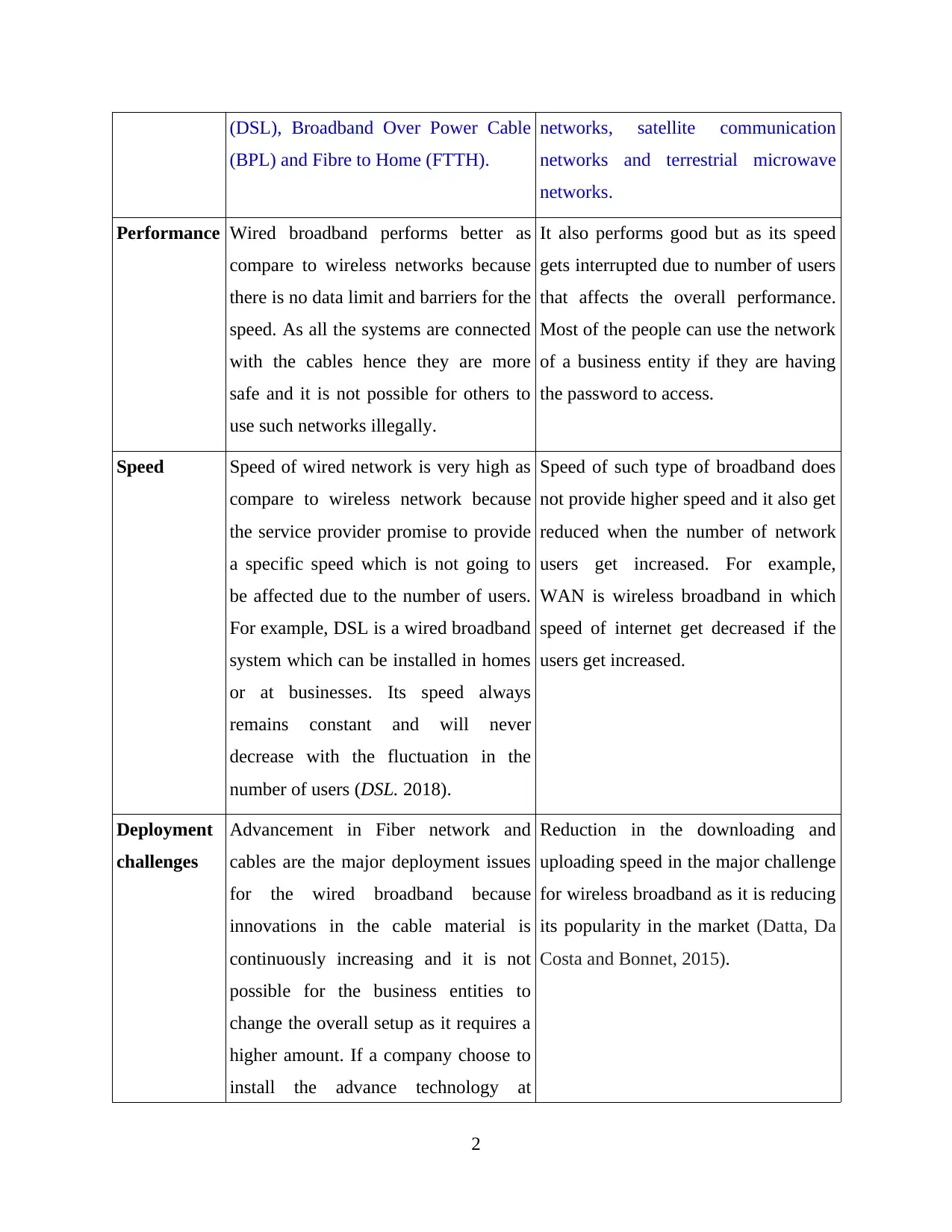
(DSL), Broadband Over Power Cable
(BPL) and Fibre to Home (FTTH).
networks, satellite communication
networks and terrestrial microwave
networks.
Performance Wired broadband performs better as
compare to wireless networks because
there is no data limit and barriers for the
speed. As all the systems are connected
with the cables hence they are more
safe and it is not possible for others to
use such networks illegally.
It also performs good but as its speed
gets interrupted due to number of users
that affects the overall performance.
Most of the people can use the network
of a business entity if they are having
the password to access.
Speed Speed of wired network is very high as
compare to wireless network because
the service provider promise to provide
a specific speed which is not going to
be affected due to the number of users.
For example, DSL is a wired broadband
system which can be installed in homes
or at businesses. Its speed always
remains constant and will never
decrease with the fluctuation in the
number of users (DSL. 2018).
Speed of such type of broadband does
not provide higher speed and it also get
reduced when the number of network
users get increased. For example,
WAN is wireless broadband in which
speed of internet get decreased if the
users get increased.
Deployment
challenges
Advancement in Fiber network and
cables are the major deployment issues
for the wired broadband because
innovations in the cable material is
continuously increasing and it is not
possible for the business entities to
change the overall setup as it requires a
higher amount. If a company choose to
install the advance technology at
Reduction in the downloading and
uploading speed in the major challenge
for wireless broadband as it is reducing
its popularity in the market (Datta, Da
Costa and Bonnet, 2015).
2
(BPL) and Fibre to Home (FTTH).
networks, satellite communication
networks and terrestrial microwave
networks.
Performance Wired broadband performs better as
compare to wireless networks because
there is no data limit and barriers for the
speed. As all the systems are connected
with the cables hence they are more
safe and it is not possible for others to
use such networks illegally.
It also performs good but as its speed
gets interrupted due to number of users
that affects the overall performance.
Most of the people can use the network
of a business entity if they are having
the password to access.
Speed Speed of wired network is very high as
compare to wireless network because
the service provider promise to provide
a specific speed which is not going to
be affected due to the number of users.
For example, DSL is a wired broadband
system which can be installed in homes
or at businesses. Its speed always
remains constant and will never
decrease with the fluctuation in the
number of users (DSL. 2018).
Speed of such type of broadband does
not provide higher speed and it also get
reduced when the number of network
users get increased. For example,
WAN is wireless broadband in which
speed of internet get decreased if the
users get increased.
Deployment
challenges
Advancement in Fiber network and
cables are the major deployment issues
for the wired broadband because
innovations in the cable material is
continuously increasing and it is not
possible for the business entities to
change the overall setup as it requires a
higher amount. If a company choose to
install the advance technology at
Reduction in the downloading and
uploading speed in the major challenge
for wireless broadband as it is reducing
its popularity in the market (Datta, Da
Costa and Bonnet, 2015).
2
Paraphrase This Document
Need a fresh take? Get an instant paraphrase of this document with our AI Paraphraser
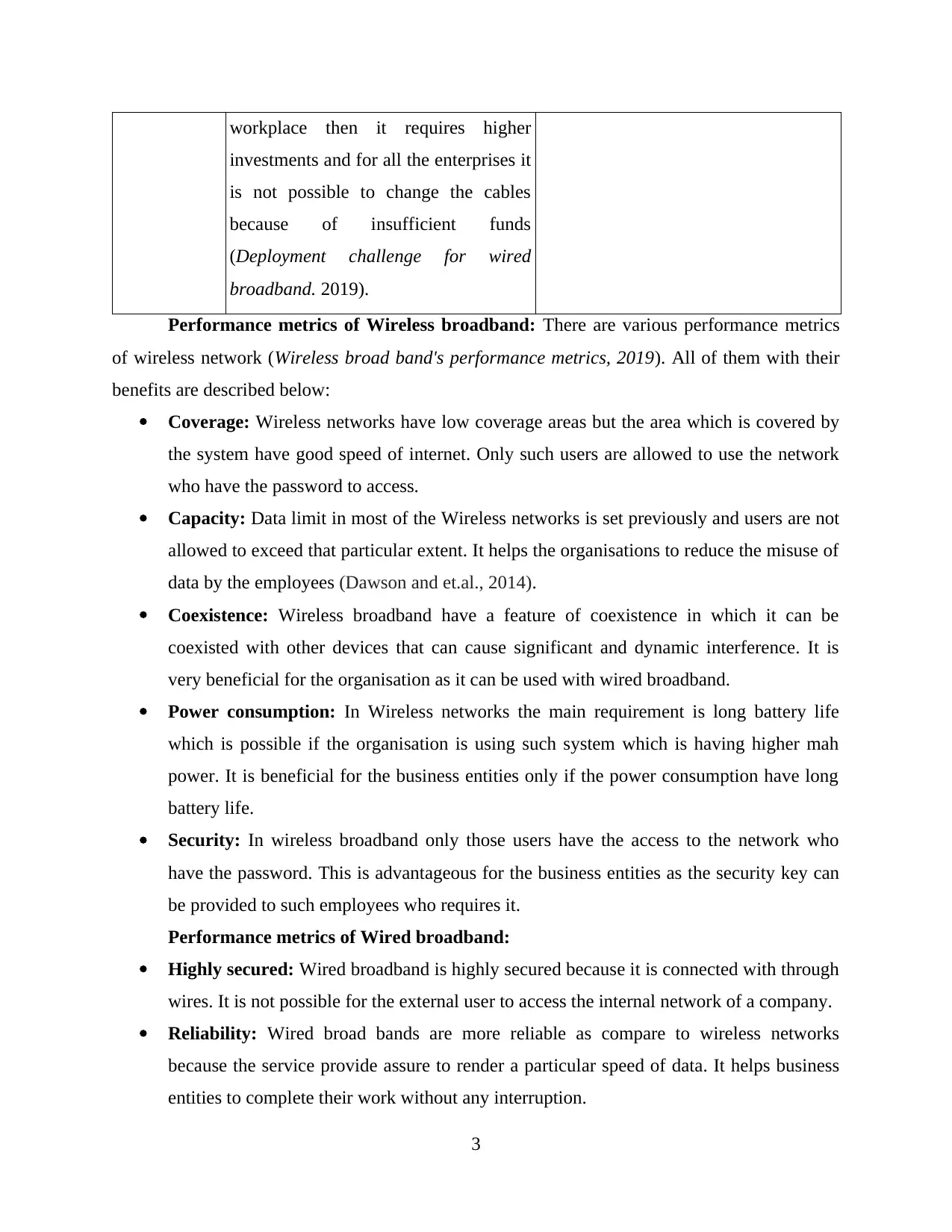
workplace then it requires higher
investments and for all the enterprises it
is not possible to change the cables
because of insufficient funds
(Deployment challenge for wired
broadband. 2019).
Performance metrics of Wireless broadband: There are various performance metrics
of wireless network (Wireless broad band's performance metrics, 2019). All of them with their
benefits are described below:
Coverage: Wireless networks have low coverage areas but the area which is covered by
the system have good speed of internet. Only such users are allowed to use the network
who have the password to access.
Capacity: Data limit in most of the Wireless networks is set previously and users are not
allowed to exceed that particular extent. It helps the organisations to reduce the misuse of
data by the employees (Dawson and et.al., 2014).
Coexistence: Wireless broadband have a feature of coexistence in which it can be
coexisted with other devices that can cause significant and dynamic interference. It is
very beneficial for the organisation as it can be used with wired broadband.
Power consumption: In Wireless networks the main requirement is long battery life
which is possible if the organisation is using such system which is having higher mah
power. It is beneficial for the business entities only if the power consumption have long
battery life.
Security: In wireless broadband only those users have the access to the network who
have the password. This is advantageous for the business entities as the security key can
be provided to such employees who requires it.
Performance metrics of Wired broadband:
Highly secured: Wired broadband is highly secured because it is connected with through
wires. It is not possible for the external user to access the internal network of a company.
Reliability: Wired broad bands are more reliable as compare to wireless networks
because the service provide assure to render a particular speed of data. It helps business
entities to complete their work without any interruption.
3
investments and for all the enterprises it
is not possible to change the cables
because of insufficient funds
(Deployment challenge for wired
broadband. 2019).
Performance metrics of Wireless broadband: There are various performance metrics
of wireless network (Wireless broad band's performance metrics, 2019). All of them with their
benefits are described below:
Coverage: Wireless networks have low coverage areas but the area which is covered by
the system have good speed of internet. Only such users are allowed to use the network
who have the password to access.
Capacity: Data limit in most of the Wireless networks is set previously and users are not
allowed to exceed that particular extent. It helps the organisations to reduce the misuse of
data by the employees (Dawson and et.al., 2014).
Coexistence: Wireless broadband have a feature of coexistence in which it can be
coexisted with other devices that can cause significant and dynamic interference. It is
very beneficial for the organisation as it can be used with wired broadband.
Power consumption: In Wireless networks the main requirement is long battery life
which is possible if the organisation is using such system which is having higher mah
power. It is beneficial for the business entities only if the power consumption have long
battery life.
Security: In wireless broadband only those users have the access to the network who
have the password. This is advantageous for the business entities as the security key can
be provided to such employees who requires it.
Performance metrics of Wired broadband:
Highly secured: Wired broadband is highly secured because it is connected with through
wires. It is not possible for the external user to access the internal network of a company.
Reliability: Wired broad bands are more reliable as compare to wireless networks
because the service provide assure to render a particular speed of data. It helps business
entities to complete their work without any interruption.
3
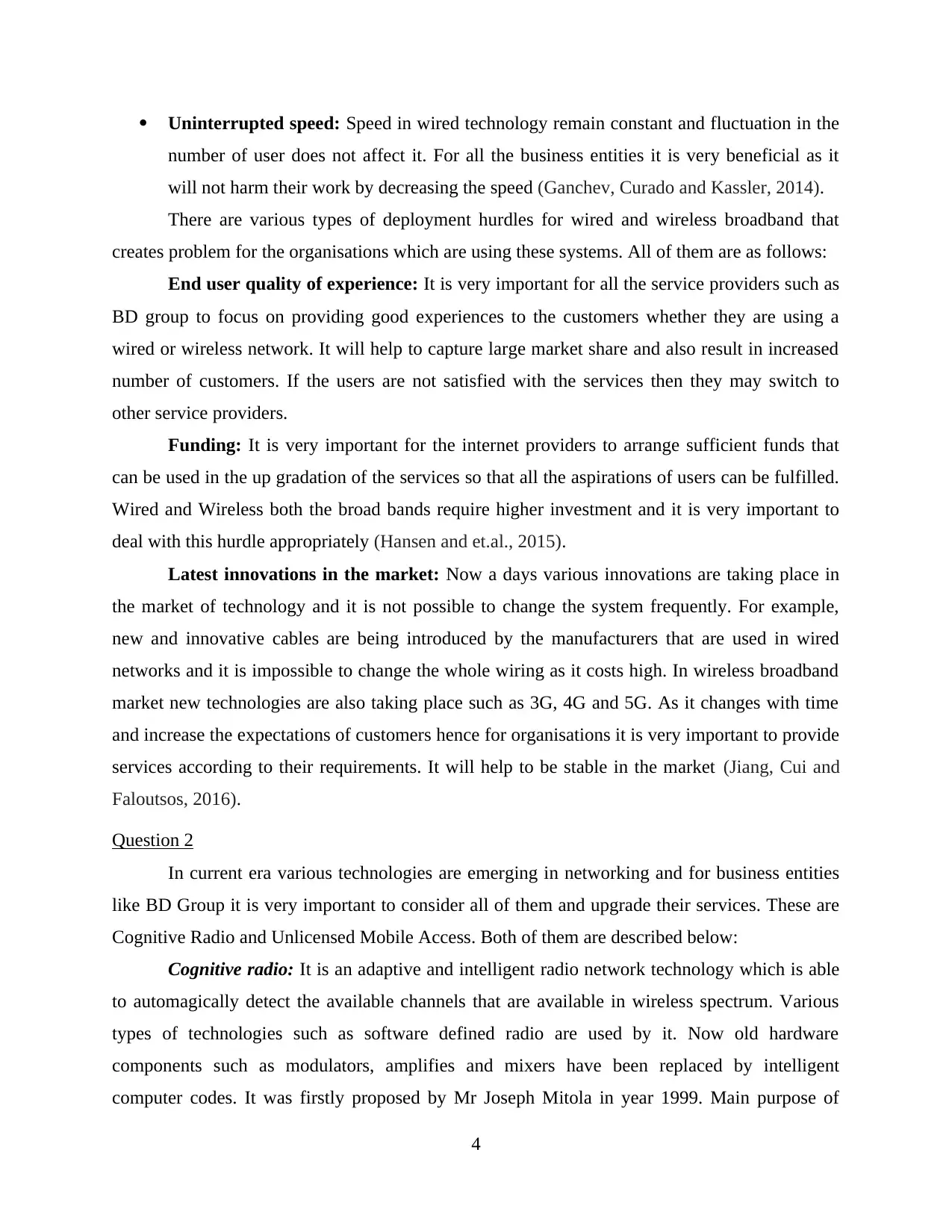
Uninterrupted speed: Speed in wired technology remain constant and fluctuation in the
number of user does not affect it. For all the business entities it is very beneficial as it
will not harm their work by decreasing the speed (Ganchev, Curado and Kassler, 2014).
There are various types of deployment hurdles for wired and wireless broadband that
creates problem for the organisations which are using these systems. All of them are as follows:
End user quality of experience: It is very important for all the service providers such as
BD group to focus on providing good experiences to the customers whether they are using a
wired or wireless network. It will help to capture large market share and also result in increased
number of customers. If the users are not satisfied with the services then they may switch to
other service providers.
Funding: It is very important for the internet providers to arrange sufficient funds that
can be used in the up gradation of the services so that all the aspirations of users can be fulfilled.
Wired and Wireless both the broad bands require higher investment and it is very important to
deal with this hurdle appropriately (Hansen and et.al., 2015).
Latest innovations in the market: Now a days various innovations are taking place in
the market of technology and it is not possible to change the system frequently. For example,
new and innovative cables are being introduced by the manufacturers that are used in wired
networks and it is impossible to change the whole wiring as it costs high. In wireless broadband
market new technologies are also taking place such as 3G, 4G and 5G. As it changes with time
and increase the expectations of customers hence for organisations it is very important to provide
services according to their requirements. It will help to be stable in the market (Jiang, Cui and
Faloutsos, 2016).
Question 2
In current era various technologies are emerging in networking and for business entities
like BD Group it is very important to consider all of them and upgrade their services. These are
Cognitive Radio and Unlicensed Mobile Access. Both of them are described below:
Cognitive radio: It is an adaptive and intelligent radio network technology which is able
to automagically detect the available channels that are available in wireless spectrum. Various
types of technologies such as software defined radio are used by it. Now old hardware
components such as modulators, amplifies and mixers have been replaced by intelligent
computer codes. It was firstly proposed by Mr Joseph Mitola in year 1999. Main purpose of
4
number of user does not affect it. For all the business entities it is very beneficial as it
will not harm their work by decreasing the speed (Ganchev, Curado and Kassler, 2014).
There are various types of deployment hurdles for wired and wireless broadband that
creates problem for the organisations which are using these systems. All of them are as follows:
End user quality of experience: It is very important for all the service providers such as
BD group to focus on providing good experiences to the customers whether they are using a
wired or wireless network. It will help to capture large market share and also result in increased
number of customers. If the users are not satisfied with the services then they may switch to
other service providers.
Funding: It is very important for the internet providers to arrange sufficient funds that
can be used in the up gradation of the services so that all the aspirations of users can be fulfilled.
Wired and Wireless both the broad bands require higher investment and it is very important to
deal with this hurdle appropriately (Hansen and et.al., 2015).
Latest innovations in the market: Now a days various innovations are taking place in
the market of technology and it is not possible to change the system frequently. For example,
new and innovative cables are being introduced by the manufacturers that are used in wired
networks and it is impossible to change the whole wiring as it costs high. In wireless broadband
market new technologies are also taking place such as 3G, 4G and 5G. As it changes with time
and increase the expectations of customers hence for organisations it is very important to provide
services according to their requirements. It will help to be stable in the market (Jiang, Cui and
Faloutsos, 2016).
Question 2
In current era various technologies are emerging in networking and for business entities
like BD Group it is very important to consider all of them and upgrade their services. These are
Cognitive Radio and Unlicensed Mobile Access. Both of them are described below:
Cognitive radio: It is an adaptive and intelligent radio network technology which is able
to automagically detect the available channels that are available in wireless spectrum. Various
types of technologies such as software defined radio are used by it. Now old hardware
components such as modulators, amplifies and mixers have been replaced by intelligent
computer codes. It was firstly proposed by Mr Joseph Mitola in year 1999. Main purpose of
4
⊘ This is a preview!⊘
Do you want full access?
Subscribe today to unlock all pages.

Trusted by 1+ million students worldwide
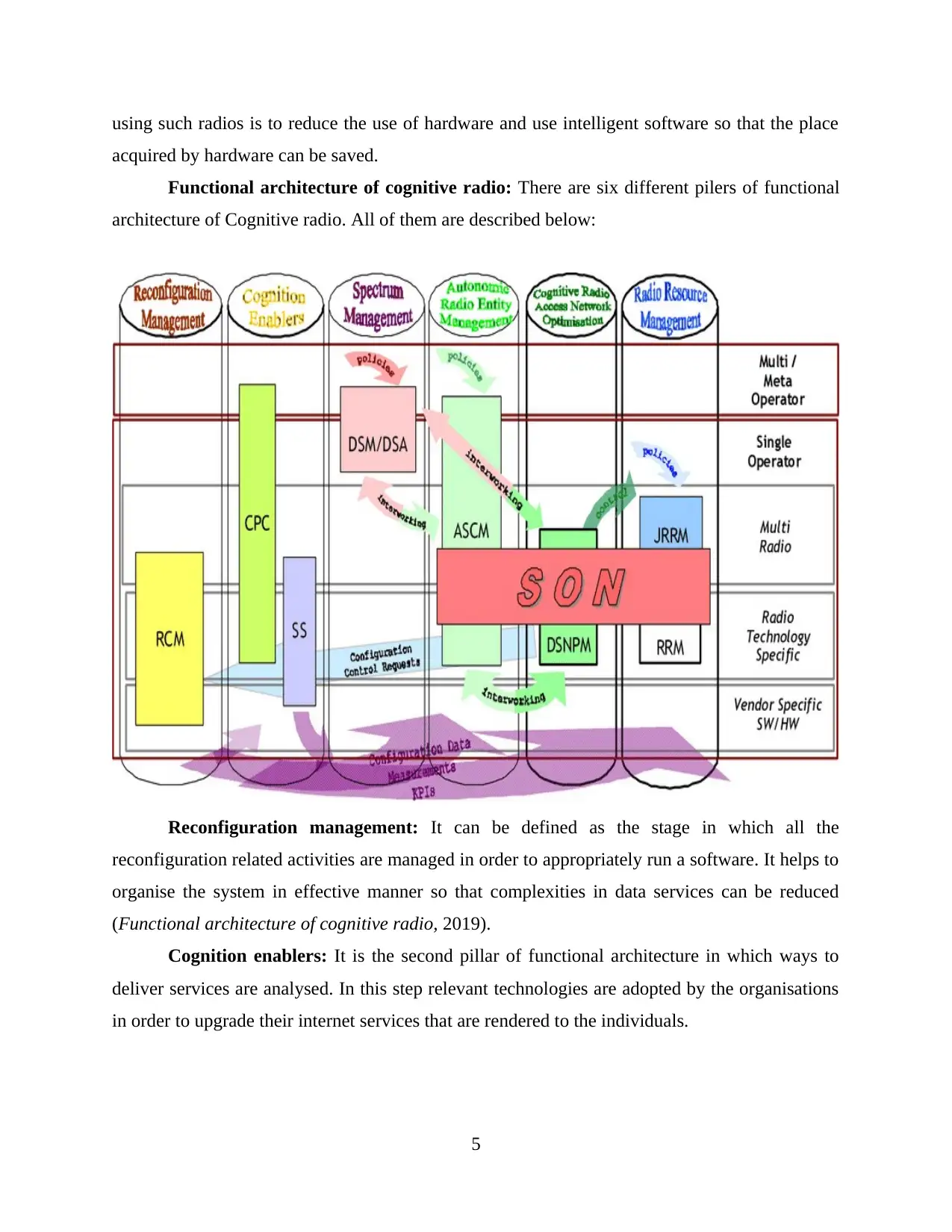
using such radios is to reduce the use of hardware and use intelligent software so that the place
acquired by hardware can be saved.
Functional architecture of cognitive radio: There are six different pilers of functional
architecture of Cognitive radio. All of them are described below:
Reconfiguration management: It can be defined as the stage in which all the
reconfiguration related activities are managed in order to appropriately run a software. It helps to
organise the system in effective manner so that complexities in data services can be reduced
(Functional architecture of cognitive radio, 2019).
Cognition enablers: It is the second pillar of functional architecture in which ways to
deliver services are analysed. In this step relevant technologies are adopted by the organisations
in order to upgrade their internet services that are rendered to the individuals.
5
acquired by hardware can be saved.
Functional architecture of cognitive radio: There are six different pilers of functional
architecture of Cognitive radio. All of them are described below:
Reconfiguration management: It can be defined as the stage in which all the
reconfiguration related activities are managed in order to appropriately run a software. It helps to
organise the system in effective manner so that complexities in data services can be reduced
(Functional architecture of cognitive radio, 2019).
Cognition enablers: It is the second pillar of functional architecture in which ways to
deliver services are analysed. In this step relevant technologies are adopted by the organisations
in order to upgrade their internet services that are rendered to the individuals.
5
Paraphrase This Document
Need a fresh take? Get an instant paraphrase of this document with our AI Paraphraser
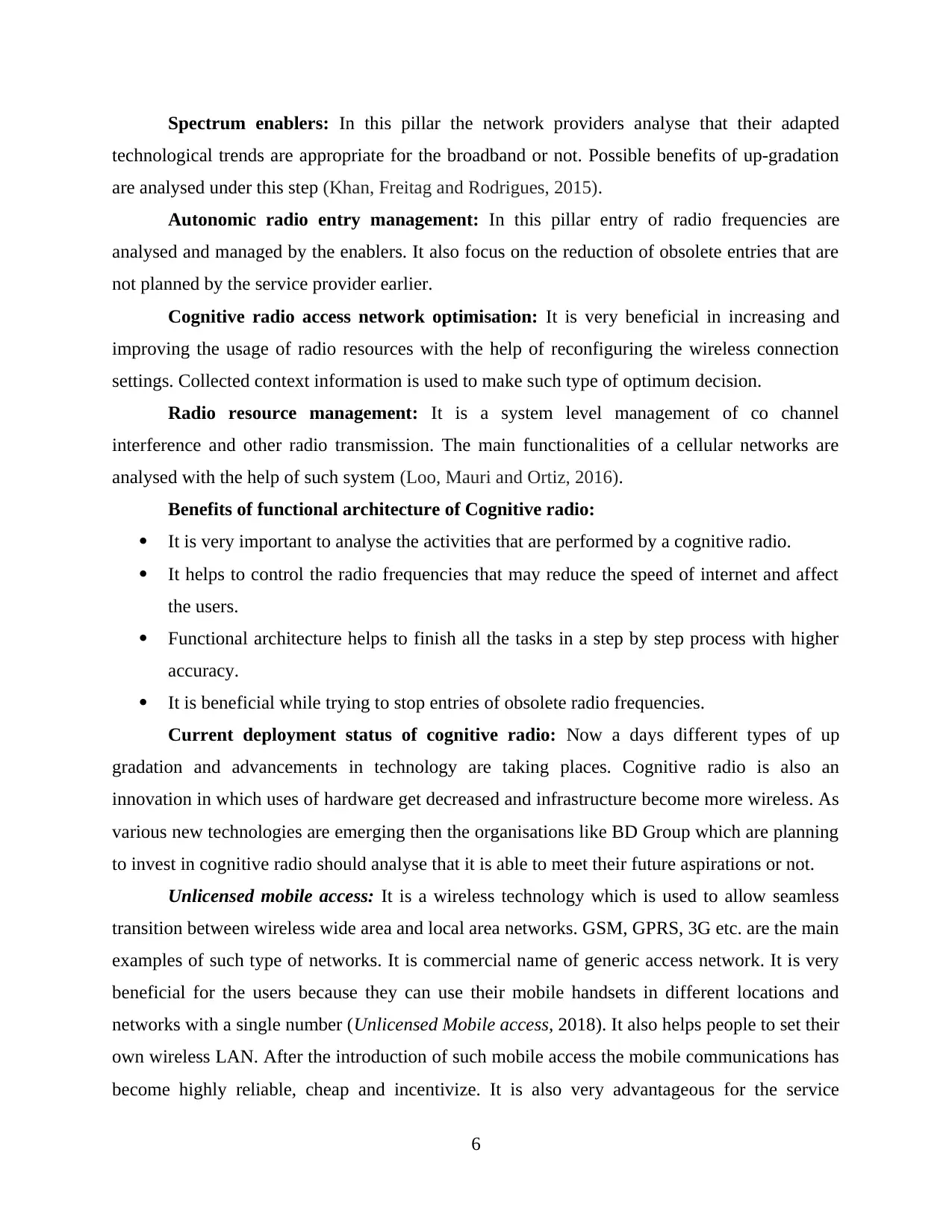
Spectrum enablers: In this pillar the network providers analyse that their adapted
technological trends are appropriate for the broadband or not. Possible benefits of up-gradation
are analysed under this step (Khan, Freitag and Rodrigues, 2015).
Autonomic radio entry management: In this pillar entry of radio frequencies are
analysed and managed by the enablers. It also focus on the reduction of obsolete entries that are
not planned by the service provider earlier.
Cognitive radio access network optimisation: It is very beneficial in increasing and
improving the usage of radio resources with the help of reconfiguring the wireless connection
settings. Collected context information is used to make such type of optimum decision.
Radio resource management: It is a system level management of co channel
interference and other radio transmission. The main functionalities of a cellular networks are
analysed with the help of such system (Loo, Mauri and Ortiz, 2016).
Benefits of functional architecture of Cognitive radio:
It is very important to analyse the activities that are performed by a cognitive radio.
It helps to control the radio frequencies that may reduce the speed of internet and affect
the users.
Functional architecture helps to finish all the tasks in a step by step process with higher
accuracy.
It is beneficial while trying to stop entries of obsolete radio frequencies.
Current deployment status of cognitive radio: Now a days different types of up
gradation and advancements in technology are taking places. Cognitive radio is also an
innovation in which uses of hardware get decreased and infrastructure become more wireless. As
various new technologies are emerging then the organisations like BD Group which are planning
to invest in cognitive radio should analyse that it is able to meet their future aspirations or not.
Unlicensed mobile access: It is a wireless technology which is used to allow seamless
transition between wireless wide area and local area networks. GSM, GPRS, 3G etc. are the main
examples of such type of networks. It is commercial name of generic access network. It is very
beneficial for the users because they can use their mobile handsets in different locations and
networks with a single number (Unlicensed Mobile access, 2018). It also helps people to set their
own wireless LAN. After the introduction of such mobile access the mobile communications has
become highly reliable, cheap and incentivize. It is also very advantageous for the service
6
technological trends are appropriate for the broadband or not. Possible benefits of up-gradation
are analysed under this step (Khan, Freitag and Rodrigues, 2015).
Autonomic radio entry management: In this pillar entry of radio frequencies are
analysed and managed by the enablers. It also focus on the reduction of obsolete entries that are
not planned by the service provider earlier.
Cognitive radio access network optimisation: It is very beneficial in increasing and
improving the usage of radio resources with the help of reconfiguring the wireless connection
settings. Collected context information is used to make such type of optimum decision.
Radio resource management: It is a system level management of co channel
interference and other radio transmission. The main functionalities of a cellular networks are
analysed with the help of such system (Loo, Mauri and Ortiz, 2016).
Benefits of functional architecture of Cognitive radio:
It is very important to analyse the activities that are performed by a cognitive radio.
It helps to control the radio frequencies that may reduce the speed of internet and affect
the users.
Functional architecture helps to finish all the tasks in a step by step process with higher
accuracy.
It is beneficial while trying to stop entries of obsolete radio frequencies.
Current deployment status of cognitive radio: Now a days different types of up
gradation and advancements in technology are taking places. Cognitive radio is also an
innovation in which uses of hardware get decreased and infrastructure become more wireless. As
various new technologies are emerging then the organisations like BD Group which are planning
to invest in cognitive radio should analyse that it is able to meet their future aspirations or not.
Unlicensed mobile access: It is a wireless technology which is used to allow seamless
transition between wireless wide area and local area networks. GSM, GPRS, 3G etc. are the main
examples of such type of networks. It is commercial name of generic access network. It is very
beneficial for the users because they can use their mobile handsets in different locations and
networks with a single number (Unlicensed Mobile access, 2018). It also helps people to set their
own wireless LAN. After the introduction of such mobile access the mobile communications has
become highly reliable, cheap and incentivize. It is also very advantageous for the service
6
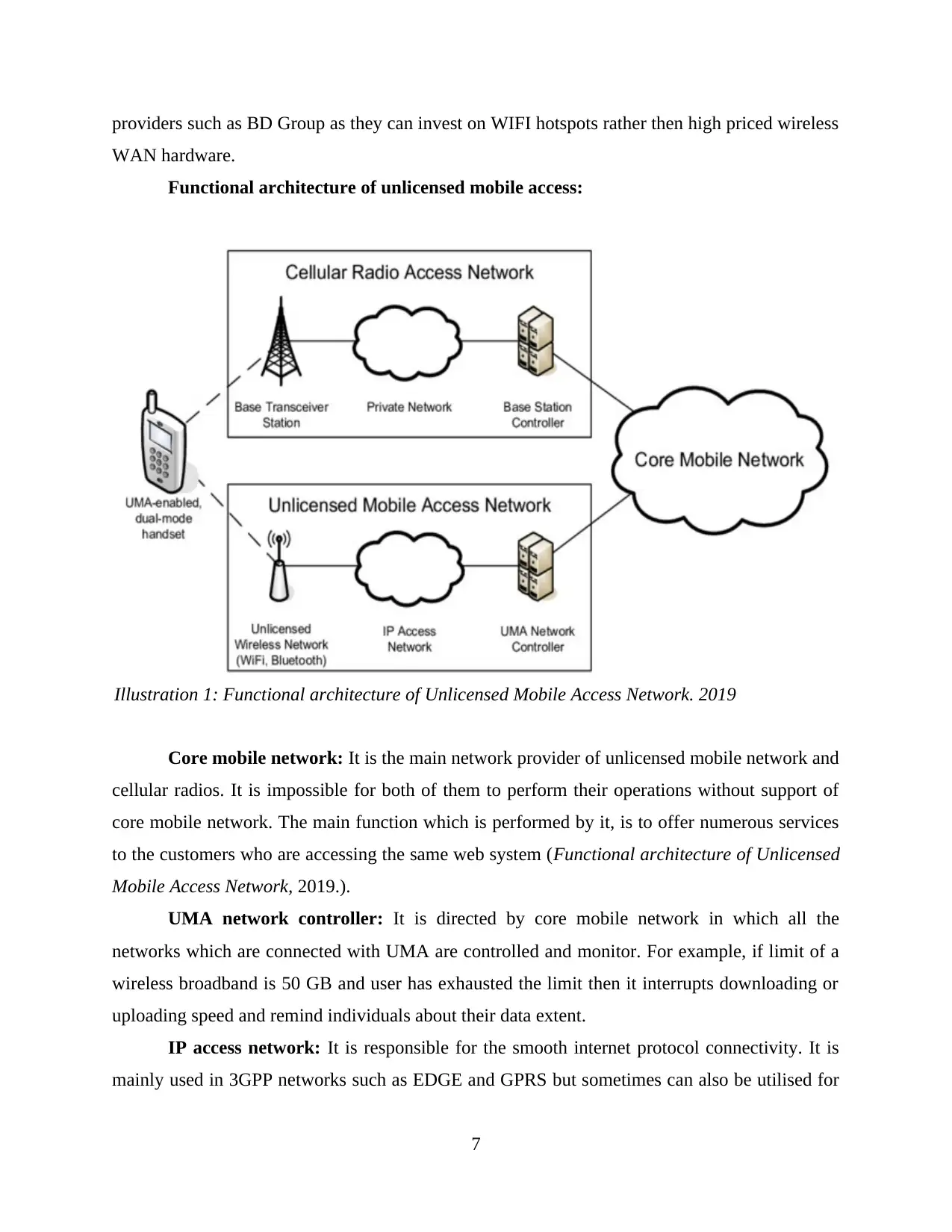
providers such as BD Group as they can invest on WIFI hotspots rather then high priced wireless
WAN hardware.
Functional architecture of unlicensed mobile access:
Core mobile network: It is the main network provider of unlicensed mobile network and
cellular radios. It is impossible for both of them to perform their operations without support of
core mobile network. The main function which is performed by it, is to offer numerous services
to the customers who are accessing the same web system (Functional architecture of Unlicensed
Mobile Access Network, 2019.).
UMA network controller: It is directed by core mobile network in which all the
networks which are connected with UMA are controlled and monitor. For example, if limit of a
wireless broadband is 50 GB and user has exhausted the limit then it interrupts downloading or
uploading speed and remind individuals about their data extent.
IP access network: It is responsible for the smooth internet protocol connectivity. It is
mainly used in 3GPP networks such as EDGE and GPRS but sometimes can also be utilised for
7
Illustration 1: Functional architecture of Unlicensed Mobile Access Network. 2019
WAN hardware.
Functional architecture of unlicensed mobile access:
Core mobile network: It is the main network provider of unlicensed mobile network and
cellular radios. It is impossible for both of them to perform their operations without support of
core mobile network. The main function which is performed by it, is to offer numerous services
to the customers who are accessing the same web system (Functional architecture of Unlicensed
Mobile Access Network, 2019.).
UMA network controller: It is directed by core mobile network in which all the
networks which are connected with UMA are controlled and monitor. For example, if limit of a
wireless broadband is 50 GB and user has exhausted the limit then it interrupts downloading or
uploading speed and remind individuals about their data extent.
IP access network: It is responsible for the smooth internet protocol connectivity. It is
mainly used in 3GPP networks such as EDGE and GPRS but sometimes can also be utilised for
7
Illustration 1: Functional architecture of Unlicensed Mobile Access Network. 2019
⊘ This is a preview!⊘
Do you want full access?
Subscribe today to unlock all pages.

Trusted by 1+ million students worldwide
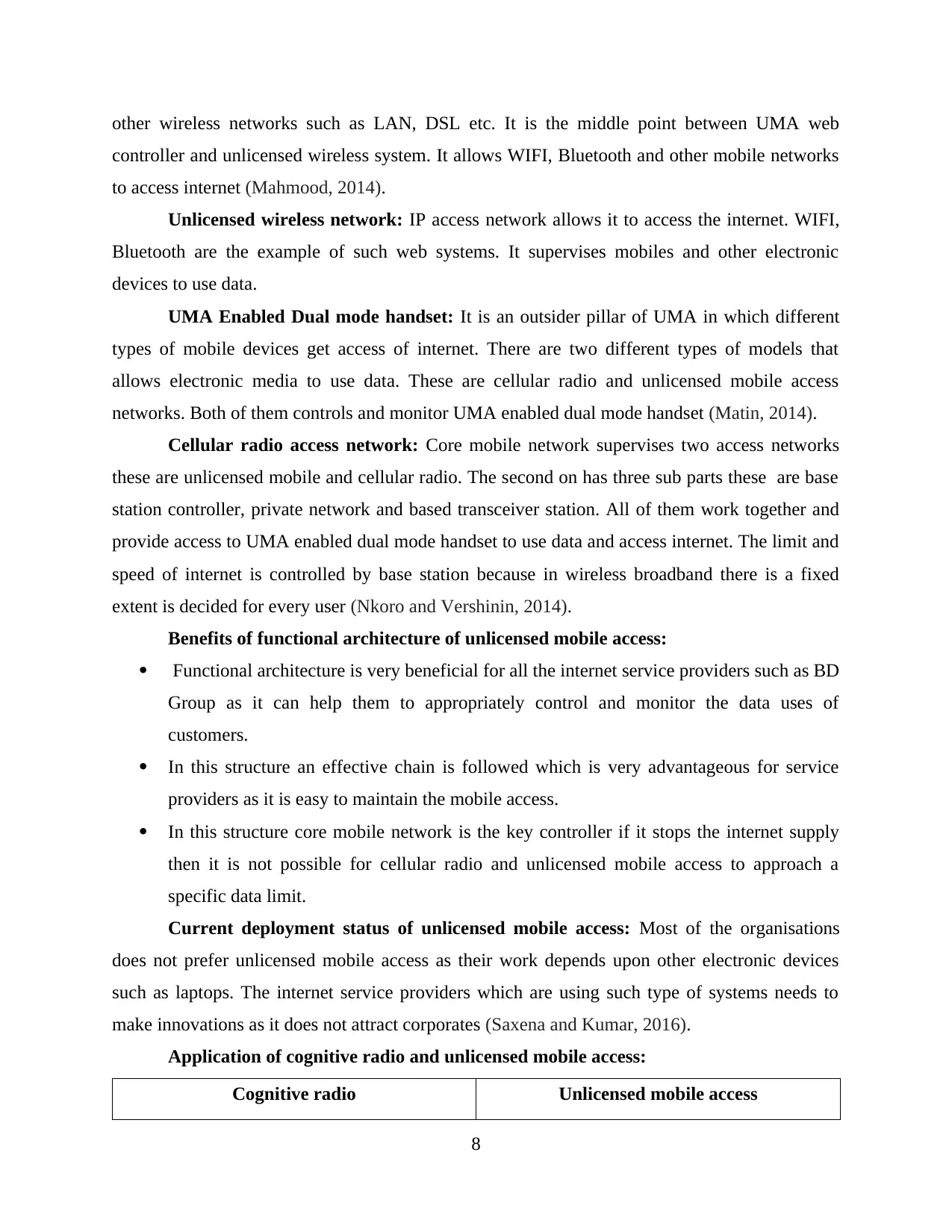
other wireless networks such as LAN, DSL etc. It is the middle point between UMA web
controller and unlicensed wireless system. It allows WIFI, Bluetooth and other mobile networks
to access internet (Mahmood, 2014).
Unlicensed wireless network: IP access network allows it to access the internet. WIFI,
Bluetooth are the example of such web systems. It supervises mobiles and other electronic
devices to use data.
UMA Enabled Dual mode handset: It is an outsider pillar of UMA in which different
types of mobile devices get access of internet. There are two different types of models that
allows electronic media to use data. These are cellular radio and unlicensed mobile access
networks. Both of them controls and monitor UMA enabled dual mode handset (Matin, 2014).
Cellular radio access network: Core mobile network supervises two access networks
these are unlicensed mobile and cellular radio. The second on has three sub parts these are base
station controller, private network and based transceiver station. All of them work together and
provide access to UMA enabled dual mode handset to use data and access internet. The limit and
speed of internet is controlled by base station because in wireless broadband there is a fixed
extent is decided for every user (Nkoro and Vershinin, 2014).
Benefits of functional architecture of unlicensed mobile access:
Functional architecture is very beneficial for all the internet service providers such as BD
Group as it can help them to appropriately control and monitor the data uses of
customers.
In this structure an effective chain is followed which is very advantageous for service
providers as it is easy to maintain the mobile access.
In this structure core mobile network is the key controller if it stops the internet supply
then it is not possible for cellular radio and unlicensed mobile access to approach a
specific data limit.
Current deployment status of unlicensed mobile access: Most of the organisations
does not prefer unlicensed mobile access as their work depends upon other electronic devices
such as laptops. The internet service providers which are using such type of systems needs to
make innovations as it does not attract corporates (Saxena and Kumar, 2016).
Application of cognitive radio and unlicensed mobile access:
Cognitive radio Unlicensed mobile access
8
controller and unlicensed wireless system. It allows WIFI, Bluetooth and other mobile networks
to access internet (Mahmood, 2014).
Unlicensed wireless network: IP access network allows it to access the internet. WIFI,
Bluetooth are the example of such web systems. It supervises mobiles and other electronic
devices to use data.
UMA Enabled Dual mode handset: It is an outsider pillar of UMA in which different
types of mobile devices get access of internet. There are two different types of models that
allows electronic media to use data. These are cellular radio and unlicensed mobile access
networks. Both of them controls and monitor UMA enabled dual mode handset (Matin, 2014).
Cellular radio access network: Core mobile network supervises two access networks
these are unlicensed mobile and cellular radio. The second on has three sub parts these are base
station controller, private network and based transceiver station. All of them work together and
provide access to UMA enabled dual mode handset to use data and access internet. The limit and
speed of internet is controlled by base station because in wireless broadband there is a fixed
extent is decided for every user (Nkoro and Vershinin, 2014).
Benefits of functional architecture of unlicensed mobile access:
Functional architecture is very beneficial for all the internet service providers such as BD
Group as it can help them to appropriately control and monitor the data uses of
customers.
In this structure an effective chain is followed which is very advantageous for service
providers as it is easy to maintain the mobile access.
In this structure core mobile network is the key controller if it stops the internet supply
then it is not possible for cellular radio and unlicensed mobile access to approach a
specific data limit.
Current deployment status of unlicensed mobile access: Most of the organisations
does not prefer unlicensed mobile access as their work depends upon other electronic devices
such as laptops. The internet service providers which are using such type of systems needs to
make innovations as it does not attract corporates (Saxena and Kumar, 2016).
Application of cognitive radio and unlicensed mobile access:
Cognitive radio Unlicensed mobile access
8
Paraphrase This Document
Need a fresh take? Get an instant paraphrase of this document with our AI Paraphraser
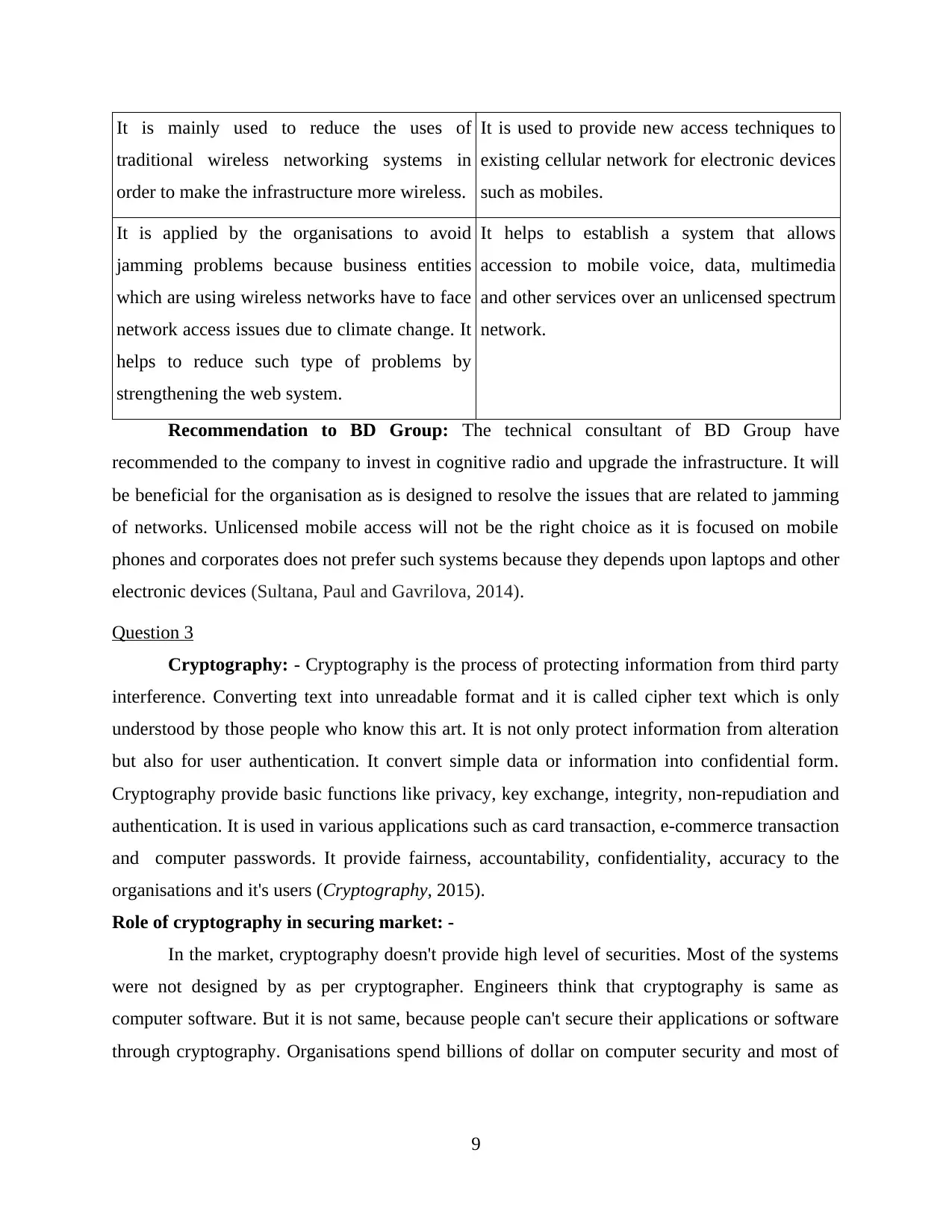
It is mainly used to reduce the uses of
traditional wireless networking systems in
order to make the infrastructure more wireless.
It is used to provide new access techniques to
existing cellular network for electronic devices
such as mobiles.
It is applied by the organisations to avoid
jamming problems because business entities
which are using wireless networks have to face
network access issues due to climate change. It
helps to reduce such type of problems by
strengthening the web system.
It helps to establish a system that allows
accession to mobile voice, data, multimedia
and other services over an unlicensed spectrum
network.
Recommendation to BD Group: The technical consultant of BD Group have
recommended to the company to invest in cognitive radio and upgrade the infrastructure. It will
be beneficial for the organisation as is designed to resolve the issues that are related to jamming
of networks. Unlicensed mobile access will not be the right choice as it is focused on mobile
phones and corporates does not prefer such systems because they depends upon laptops and other
electronic devices (Sultana, Paul and Gavrilova, 2014).
Question 3
Cryptography: - Cryptography is the process of protecting information from third party
interference. Converting text into unreadable format and it is called cipher text which is only
understood by those people who know this art. It is not only protect information from alteration
but also for user authentication. It convert simple data or information into confidential form.
Cryptography provide basic functions like privacy, key exchange, integrity, non-repudiation and
authentication. It is used in various applications such as card transaction, e-commerce transaction
and computer passwords. It provide fairness, accountability, confidentiality, accuracy to the
organisations and it's users (Cryptography, 2015).
Role of cryptography in securing market: -
In the market, cryptography doesn't provide high level of securities. Most of the systems
were not designed by as per cryptographer. Engineers think that cryptography is same as
computer software. But it is not same, because people can't secure their applications or software
through cryptography. Organisations spend billions of dollar on computer security and most of
9
traditional wireless networking systems in
order to make the infrastructure more wireless.
It is used to provide new access techniques to
existing cellular network for electronic devices
such as mobiles.
It is applied by the organisations to avoid
jamming problems because business entities
which are using wireless networks have to face
network access issues due to climate change. It
helps to reduce such type of problems by
strengthening the web system.
It helps to establish a system that allows
accession to mobile voice, data, multimedia
and other services over an unlicensed spectrum
network.
Recommendation to BD Group: The technical consultant of BD Group have
recommended to the company to invest in cognitive radio and upgrade the infrastructure. It will
be beneficial for the organisation as is designed to resolve the issues that are related to jamming
of networks. Unlicensed mobile access will not be the right choice as it is focused on mobile
phones and corporates does not prefer such systems because they depends upon laptops and other
electronic devices (Sultana, Paul and Gavrilova, 2014).
Question 3
Cryptography: - Cryptography is the process of protecting information from third party
interference. Converting text into unreadable format and it is called cipher text which is only
understood by those people who know this art. It is not only protect information from alteration
but also for user authentication. It convert simple data or information into confidential form.
Cryptography provide basic functions like privacy, key exchange, integrity, non-repudiation and
authentication. It is used in various applications such as card transaction, e-commerce transaction
and computer passwords. It provide fairness, accountability, confidentiality, accuracy to the
organisations and it's users (Cryptography, 2015).
Role of cryptography in securing market: -
In the market, cryptography doesn't provide high level of securities. Most of the systems
were not designed by as per cryptographer. Engineers think that cryptography is same as
computer software. But it is not same, because people can't secure their applications or software
through cryptography. Organisations spend billions of dollar on computer security and most of
9

the time it waste because of insecure products. Their is a difference between two security pattern
and only experienced cryptographer can identify the gap.
Those people who interrupting cryptographic system and try to cheat with rules, they can
attack a system by using technique. It is not matter that how much money people spend on their
security system. Such as home security system and other computer system it will not stand
against this attack. Computer thieves steal data such as technical, collude, modify software and
bribe insiders. In the future, number of fraud will be increase but if people wants to secure their
data than they have to spend on security. Also know about each and every loop hole of that
security system.
Methods of cryptography: -
Secret key Cryptography (SKC): - In this method used only single key for both
encryption and decryption. Encryption means convert data into meaningless format and
decryption means transfer cipher text into plain text. Sender used that key to convert data
into encrypt form and send to the receiver in the cipher text form. Receiver also use the
same format like decrypt the text and converted in plain text. Single key used for the both
functions and it is also called symmetric encryption. It is primary used for confidentiality
and for privacy. Symmetric encryption is applied for confidentiality and make sure that
data is delivered to intended party or recipient. For example: - if two people securing
their data with secret key and third party get the access of key. In that case third party can
understand secret massage and he can interrupt between two parties. If third don't have
access than information is secure between two parties (Yassine, Rahimi and
Shirmohammadi, 2015).
Public key Cryptography (PKC): - In this method use one key for encryption and
another one is for decryption. It is also called asymmetric encryption and used for non-
repudiation, key exchange and authentication. Two keys are used in public key
cryptography first one is public key which is freely used by all. Second one is privet key
which remains a secrete for others. Public key used for encryption and private key is used
for decryption. It is applicable when one key used for encrypt and second one is to
decrypt message. For example: - when whatsapp is installed in user's phone after that
private key is registered with whatsapp server. In that case public key in not stored in the
whatsapp server.
10
and only experienced cryptographer can identify the gap.
Those people who interrupting cryptographic system and try to cheat with rules, they can
attack a system by using technique. It is not matter that how much money people spend on their
security system. Such as home security system and other computer system it will not stand
against this attack. Computer thieves steal data such as technical, collude, modify software and
bribe insiders. In the future, number of fraud will be increase but if people wants to secure their
data than they have to spend on security. Also know about each and every loop hole of that
security system.
Methods of cryptography: -
Secret key Cryptography (SKC): - In this method used only single key for both
encryption and decryption. Encryption means convert data into meaningless format and
decryption means transfer cipher text into plain text. Sender used that key to convert data
into encrypt form and send to the receiver in the cipher text form. Receiver also use the
same format like decrypt the text and converted in plain text. Single key used for the both
functions and it is also called symmetric encryption. It is primary used for confidentiality
and for privacy. Symmetric encryption is applied for confidentiality and make sure that
data is delivered to intended party or recipient. For example: - if two people securing
their data with secret key and third party get the access of key. In that case third party can
understand secret massage and he can interrupt between two parties. If third don't have
access than information is secure between two parties (Yassine, Rahimi and
Shirmohammadi, 2015).
Public key Cryptography (PKC): - In this method use one key for encryption and
another one is for decryption. It is also called asymmetric encryption and used for non-
repudiation, key exchange and authentication. Two keys are used in public key
cryptography first one is public key which is freely used by all. Second one is privet key
which remains a secrete for others. Public key used for encryption and private key is used
for decryption. It is applicable when one key used for encrypt and second one is to
decrypt message. For example: - when whatsapp is installed in user's phone after that
private key is registered with whatsapp server. In that case public key in not stored in the
whatsapp server.
10
⊘ This is a preview!⊘
Do you want full access?
Subscribe today to unlock all pages.

Trusted by 1+ million students worldwide
1 out of 17
Related Documents
Your All-in-One AI-Powered Toolkit for Academic Success.
+13062052269
info@desklib.com
Available 24*7 on WhatsApp / Email
![[object Object]](/_next/static/media/star-bottom.7253800d.svg)
Unlock your academic potential
Copyright © 2020–2025 A2Z Services. All Rights Reserved. Developed and managed by ZUCOL.





